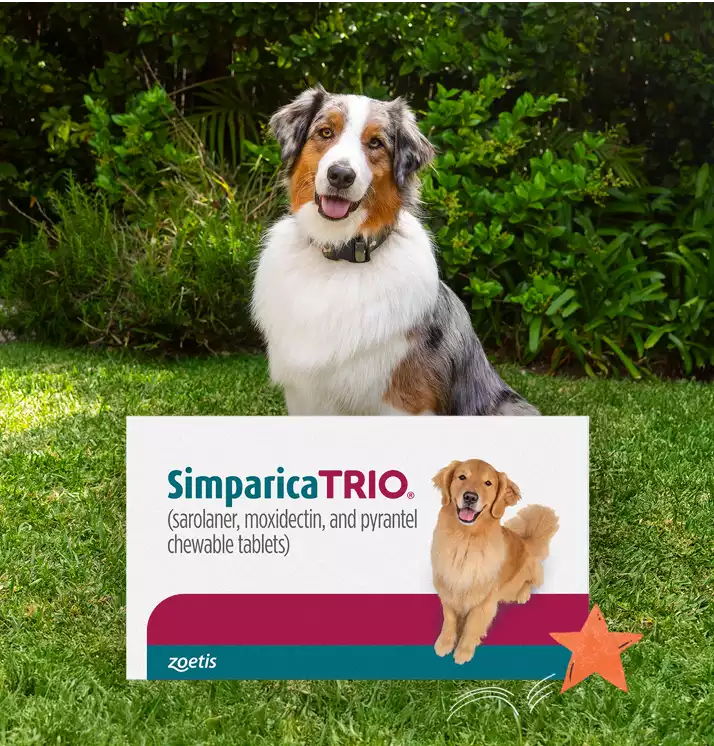Don’t Just Protect. Triple Protect
Ask your vet for Simparica Trio—a tasty, monthly chew that protects your dog from:
- Heartworm Disease
- Ticks & Fleas
- Roundworms & Hookworms

Simparica Trio is the #1 Vet Prescribed Combo Preventative1
Why It's So Important to Protect Your Best Friend
An infected mosquito can transmit this potentially fatal disease with just a single bite.
- Heartworm disease is a year-round threat that’s been diagnosed in all 50 states.
Heartworm disease is easily prevented but hard to treat, so it’s important to keep your dog protected.
†Studies to support FDA approval showed that 1 dose provided 100% protection against heartworm disease.
Ticks are found year-round, in every part of the U.S,3 while fleas can quickly infest your home.
- It just takes 1 infected tick to spread diseases (like Lyme disease) that can be harmful, even deadly, to dogs.4,5
Simparica Trio is the only FDA-approved combo preventative to treat and control 6 kinds of ticks, including the deer tick that may carry Lyme infections.
- Fleas start to bite within 5 minutes.6 Those bites can also spread infectious diseases.7
- Simparica Trio kills fleas before they can lay eggs. In studies, it started killing within 4 hours with 100% effectiveness in 8 hours.
Roundworms and hookworms can hurt your dog.
Symptoms include stomach swelling, vomiting, diarrhea, and dehydration.
Infected dogs can contaminate the home and yard, putting other pets and people at risk.
Puppies are commonly infected through breast milk and exposure before birth.
Success Stories from Pet Owners and Vets
Hear from real pet owners and vets about how Simparica Trio’s tasty chewable has helped over 15 million dogs all across the US.2
Protect Your Dog and Earn Up To $54 in Rewards
With Petcare Rewards, you can turn eligible Simparica Trio purchases into redeemable points that help save money on future vet visits.

Keep Your Dog Protected
Pests are active year-round, so it's important to stay on track with your dog’s protection.
- Download The Pack app, where you can set customizable dose and refill reminders
Manage more than just reminders — track daily routines, and stay on top of health details.

Frequently Asked Questions
Simparica Trio is the first monthly chewable to protect dogs against heartworm disease, 6 types of ticks, fleas, roundworms and hookworms, all in only one monthly chewable.
Simparica Trio has been demonstrated safe for dogs as young as 8 weeks old, and weighing as little as 2.8 lbs.
Give a Simparica Trio chewable to your dog once a month.
Talk to your veterinarian about switching to Simparica Trio from another preventive medication to ensure your dog is kept protected through the process.
Yes. Your veterinarian can prescribe the correct dose for your dog. Talk to your vet today about Simparica Trio.
If a dose is missed, a new dose should be given immediately. If a dose is vomited or spit out, a new dose should be given again. Then, continue on the prescribed monthly dosing schedule.
Simparica Trio works to get rid of ticks and fleas on dogs fast. It starts to kill deer ticks within 8 hours, and fleas within 4 hours.
You can begin using Simparica Trio with puppies as young as 8 weeks old weighing at least 2.8 lbs.
Simparica Trio is FDA-approved to prevent infections that may cause Lyme disease by killing deer ticks.
Important Safety Information: See Prescribing Information. Use with caution in dogs with a history of seizures. Simparica Trio contains sarolaner, a member of the isoxazoline class which has been associated with neurologic adverse reactions including tremors, ataxia, and seizures in dogs with or without a history of neurologic disorders. The safe use of Simparica Trio has not been evaluated in breeding, pregnant, or lactating dogs. The most frequently reported adverse reactions in clinical trials were vomiting and diarrhea.
SIMPARICA TRIO is indicated for the prevention of heartworm disease caused by Dirofilaria immitis and for the treatment and control of roundworm (immature adult and adult Toxocara canis and adult Toxascaris leonina) and hookworm (L4, immature adult, and adult Ancylostoma caninum and adult Uncinaria stenocephala) infections. SIMPARICA TRIO kills adult fleas (Ctenocephalides felis) and is indicated for the treatment and prevention of flea infestations, and the treatment and control of tick infestations with Amblyomma americanum (lone star tick), Amblyomma maculatum (Gulf Coast tick), Dermacentor variabilis (American dog tick), Ixodes scapularis (black-legged tick), Rhipicephalus sanguineus (brown dog tick), and Haemaphysalis longicornis (Asian longhorned tick) for one month in dogs and puppies 8 weeks of age and older, and weighing 2.8 pounds or greater. SIMPARICA TRIO is indicated for the prevention of Borrelia burgdorferi infections as a direct result of killing Ixodes scapularis vector ticks.
*For the treatment and control of Amblyomma americanum, Amblyomma maculatum, Dermacentor variabilis, Haemaphysalis longicornis, Ixodes scapularis, Rhipicephalus sanguineus. ‡Simparica Trio starts killing fleas within 4 hours. §For the treatment of roundworm (immature adult and adult Toxocara canis and adult Toxascaris leonina) and treatment of hookworm (L4, immature adult, and adult Ancylostoma caninum and adult Uncinaria stenocephala) infections. Indicated for the prevention of Dipylidium caninum (tapeworm) infections, by killing fleas.
References:
- Kynetec PetTrack US FTH National Data January 10, 2025.
- Simparica Trio - 15M Dogs and Counting, PetTrak Kynetec Veterinary Channel Review Q4, 2024.
- Centers for Disease Control and Prevention. Geographic distribution of ticks that bite humans. http://www.cdc.gov/ticks/geographic_distribution.html. Updated June 1, 2015. Accessed March 31, 2025.
- How ticks spread disease. Centers for Disease Control and Prevention website. https://www.cdc.gov/ticks/life_cycle_and_hosts.html. Updated January 10, 2019. Accessed March 31, 2025.
- Little SE. Changing paradigms in understanding transmission of canine tick-borne diseases: the role of interrupted feeding and intrastadial transmission. In: Proceedings of the 2nd Canine Vector-Borne Disease (CVBD) Symposium; April 25-28, 2007; Sicily, Italy.
- Byron L. Blagburn BS, MS, PhD*, Michael W. Dryden DVM, PhD. Veterinary Clinics of North America: Small Animal Practice, 2009, Biology, treatment and control of flea and tick infestations. 2009 http://doi.org/10.1016/j.cvsm.2009.07.001
- Flea Allergy Dermatitis in Cats and Dogs. VetStreet website. http://www.vetstreet.com/care/flea-allergy-dermatitis-in-cats-and-dogs. Updated Apr 22, 2014. Accessed March 31, 2025.




